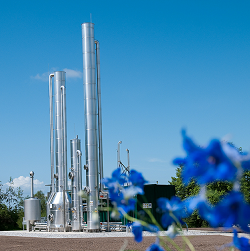|
Agriculture
Sewage treatment plant Mini-complexes
General information about biogas
Biogas is mainly referred to as a gas composed by 55-65% of methane, 30-35% of the carbon dioxide and impurities, and released during the fermentation of high molecular weight organic compounds.
While the process of Fermentation high molecular organic material (substrate) resolve to low molecular weight compounds with forming methane and carbon dioxide. Fermentation is the result of microoranism’ activity, which are not required for the oxygen for life. That means that, the process occurs in an anaerobic environment, but with sufficient moisture.
|
 |
Depending on the feedstock, biogas may contain various impurities, including unwanted while using biogas, such as sulfur and its compounds. In such cases, the biogas is purified before use.
Digested residue is in most cases an excellent organic fertilizer.
|
 |
The raw material for biogas production can be:
- In agriculture: animal manure, poultry manure, silos, any green material.
- Industry: waste processing of meat, fats and proteins, waste products of alcohol and other organic waste.
- In communal services: the sludge from wastewater treatment plants and landfill waste, food waste, catering.
The highest prevalence of biogas technology was in agriculture and public utilities sector, and the waste industry often serve as a supplement to the main raw materials to improve the efficiency of gasification. |
To ensure the efficient operation of the biogas plant - a specific organization of the collection of raw materials - manure, silage, green material or sludge, as well as its original characteristics and especially humidity are required. Very high humidity requires large amounts of tanks and fermenters (reactors, where the anaerobic fermentation is in process), which significantly increases the capital cost of the construction.
For example, when manure humidity is above 96% it is very inefficient to organize the construction of a biogas plant. However, if you add to this substance, for example silage, the efficiency is greatly increased, and the biogas plant become fully economically productive.
|
|
The use of biogas.
The biogas as a natural gas contains methane, it is also an energy fuel. But the content of methane, the main component of natural gas, is less in biogas than in natural one. That affects the calorific capacity of biogas and thus energy content comparedwith natural gas.
However biogas - is an excellent fuel. It can be burned in boilers to obtain the heat (steam and water), it can be used as a motor fuel in engines including generating plants, which produce electricity and heat, and is called cogeneration.
Before burning of biogas an arrangement is providing in different settings: mostly drying and removal of sulfur. Then, with the help of compressor the necessary pressure in the combustion chamber is provided.
|
 |
Biogas has a significant place in the energy mix as leading and developing countries. Leaders of biogas technology use in Europe are Germany and Denmark.
Biogas is used in Europe not only as fuel to generate electricity and heat, but also as a motor fuel for vehicles.
|
|